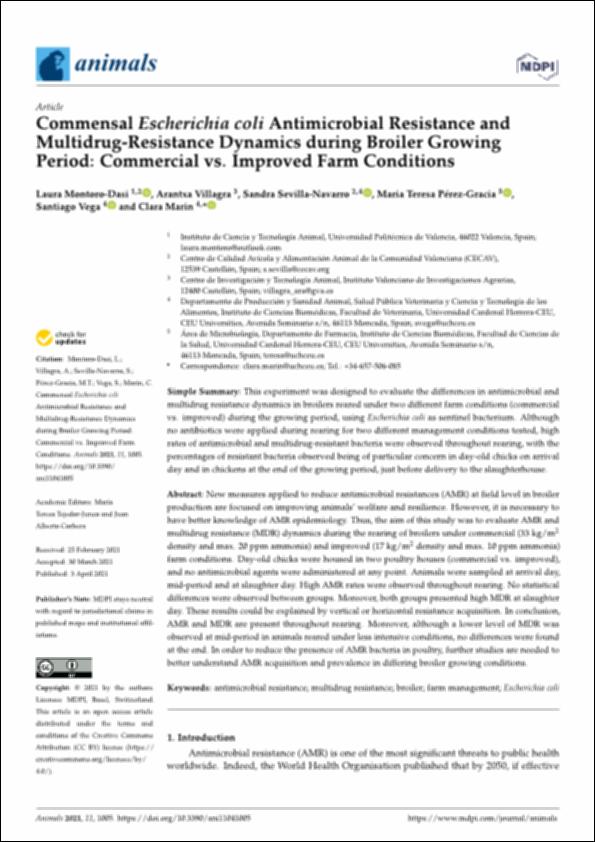Please use this identifier to cite or link to this item:
http://hdl.handle.net/10637/13460Commensal "Escherichia coli" antimicrobial resistance and multidrug-resistance dynamics during broiler growing period : commercial vs. improved farm conditions
| Title: | Commensal "Escherichia coli" antimicrobial resistance and multidrug-resistance dynamics during broiler growing period : commercial vs. improved farm conditions |
| Authors : | Montoro Dasí, Laura Villagrá García, Aránzazu Sevilla Navarro, Sandra Pérez Gracia, María Teresa. Vega García, Santiago Marín Orenga, Clara |
| Keywords: | Vibriosis - España - Comunidad Valenciana.; Aves de corral - Enfermedades infecciosas.; Gallinas - Cría y explotación.; Hens - Breeding.; Escherichia coli - Resistencia a los medicamentos.; Vibriosis - Spain - Valencia (Autonomous Community); Poultry - Communicable diseases.; Granjas avícolas.; Poultry hatcheries.; Bacterias Gram-Negativas.; Gram-Negative Bacteria.; Drug resistance in Escherichia coli. |
| Publisher: | MDPI |
| Citation: | Montoro-Dasi, L., Villagra, A., Sevilla-Navarro, S., Pérez-Gracia, M.T., Vega, S. & Marin, C. (2021). Commensal "Escherichia coli" antimicrobial resistance and multidrug-resistance dynamics during broiler growing period : commercial vs. improved farm conditions. Animals, vol. 11, i. 4 (03 apr.), art. 1005. DOI: https://doi.org/10.3390/ani11041005 |
| Abstract: | New measures applied to reduce antimicrobial resistances (AMR) at field level in broiler production are focused on improving animals’ welfare and resilience. However, it is necessary to have better knowledge of AMR epidemiology. Thus, the aim of this study was to evaluate AMR and multidrug resistance (MDR) dynamics during the rearing of broilers under commercial (33 kg/m2 density and max. 20 ppm ammonia) and improved (17 kg/m2 density and max. 10 ppm ammonia) farm conditions. Day-old chicks were housed in two poultry houses (commercial vs. improved), and no antimicrobial agents were administered at any point. Animals were sampled at arrival day, mid-period and at slaughter day. High AMR rates were observed throughout rearing. No statistical differences were observed between groups. Moreover, both groups presented high MDR at slaughter day. These results could be explained by vertical or horizontal resistance acquisition. In conclusion, AMR and MDR are present throughout rearing. Moreover, although a lower level of MDR was observed at mid-period in animals reared under less intensive conditions, no differences were found at the end. In order to reduce the presence of AMR bacteria in poultry, further studies are needed to better understand AMR acquisition and prevalence in differing broiler growing conditions. |
| Description: | Este artículo se encuentra disponible en la siguiente URL: https://www.mdpi.com/2076-2615/11/4/1005 Este artículo pertenece al número especial "Animal Infectious Diseases Caused by Multidrug-Resistant Bacteria: A One-Health Issue". |
| URI: | http://hdl.handle.net/10637/13460 |
| Rights : | http://creativecommons.org/licenses/by/4.0/deed.es |
| ISSN: | 2076-2615 (Electrónico) |
| Issue Date: | 3-Apr-2021 |
| Center : | Universidad Cardenal Herrera-CEU |
| Appears in Collections: | Dpto. Producción y Sanidad Animal, Salud Pública Veterinaria y Ciencia y Tecnología de los Alimentos |
Items in DSpace are protected by copyright, with all rights reserved, unless otherwise indicated.


